We use cookies - Our website uses cookies to provide you with a better experience and for analytical purposes. For more information on our privacy practices and cookie policy please read our Privacy Policy.
Laser vs Lamp Based Projectors
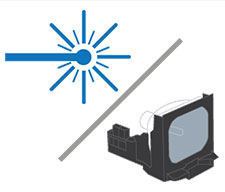

A few years ago there was only one type of light source for projectors: lamps. Now, while lamp based projectors are still very popular, you can also choose projectors with solid state light sources (SSL) such as LED or laser.
As most LED projectors tend to be at the lower end of the brightness scale (below 1000 lumens), for the purpose of this guide and for comparison, we will concentrate on laser and lamp based projectors.
LAMP BASED PROJECTORS
About projector lamps
As the name suggests, lamp based projectors use a lamp as a light source.
These aren't your typical light bulbs, they are highly specialised and powerful lamps capable of producing very high brightness levels.
In technical terms, digital projector lamps consist of a module (or frame) in which sits a bulb. The bulb is filled with ultra-highly pressurised mercury vapor which is ionised by an electric arc so the lamp can produce its full light output.
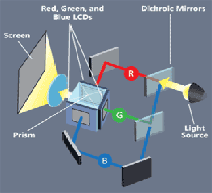

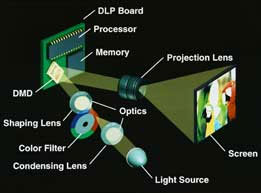

With lamp and projection technology evolving over the years, lamps have seen major improvements in terms of brightness, lifespan and price.
Lamp life
The brightness of a projector lamp will decrease gradually as it gets used. Manufacturers recommend that a projector lamp is replaced when it reaches 50% of its initial output; they call the time it takes for a lamp to reach this level 'lamp life'.
Some projectors will allow you to continue using the lamp for longer, until it fails, but note that the image quality will be much lower with an old lamp and there is a risk of it shattering if it is used well beyond the recommended replacement time.
Generally, the brighter the projector, the lower the lamp life.
Some years ago it wasn't uncommon for a lamp life to be around 1000hrs, but today's projectors often boast lamp lives of up to 10.000hrs in eco mode. To put this number into perspective, 10.000hrs means nearly 3.5 years of using the projector every single day of the year for 8 hours before needing to replace the lamp.
Lamp-based projector ownership cost
The price of lamps varies depending on the manufacturer and projector model.
Over the years prices have decreased drastically and while they often cost £200 or more 10 years ago, many projectors now have replacement lamps costing in the region of £50 to £80 +vat bringing the cost of ownership down.
In addition to the price of the lamp, you may need to consider the cost of fitting the lamps (e.g. if you need to hire a professional to service the projector), especially if the projector is mounted high up. While lamps are easy to swap, if a professional service is required, this would add to the cost of ownership.
Why choose a lamp based projector?
Compared to laser projectors, lamp-based models are lower in upfront cost. Also unlike laser projectors, the light source can be replaced as many times as needed throughout the life of the projector without having to purchase a whole new projector.
If you plan on using the projector just a few hours a week a lamp based projector is ideal.
Advantages and Disadvantages of lamp-based projectors
Advantages
- Lamp based projectors cost less upfront.
- A lamp based projector would be more cost effective if it is used intermittently.
- Some lamps have a long lifespan with low cost and can be replaced, a laser light source cannot be replaced.
Disadvantages
- Lamps need to be replaced so the cost of ownership can be higher if the projector is used often.
- The lamp brightness and colours will fade as the lamp gets closer to the end of its life.
- Projectors with lamps have a warm up and cool down time so they are slower to start-up and take longer to be able to be moved.
LASER PROJECTORS
About laser projectors
Laser projection is one of the fastest growing product category in the AV industry.
With more models available and prices decreasing over time, customers are more and more interested in what laser projectors can bring.
A laser light source is a solid-state technology using laser diodes to generate light.
There are several types of laser technology for projectors. The most common is laser phosphor which uses blue lasers, phosphor wheels and filters to produce colours, but there are also RB and RGB laser light sources which use red and blue or red, blue and green lasers for an even wider colour range. See below some diagrams of the various types courtesy of NEC.
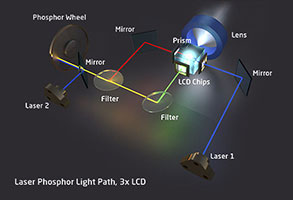

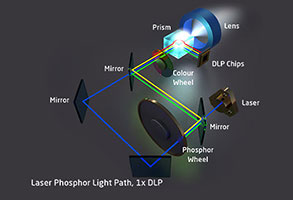

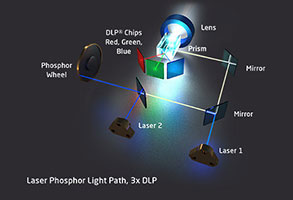

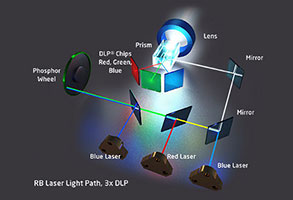



Laser lifespan
Laser light sources have an expected lifespan of 20.000hrs (more on some models).
Unlike lamps, lasers don't suffer so much with brightness declining during their life time so the projected image will remain clear and bright throughout.
Lasers cannot at this time be replaced so when the laser light source fails, you would need to replace the whole projector. With a lifespan of 20.000hrs, this means you would need to replace the projector after nearly 7 years of using the projector every single day for 8 hours.
Laser ownership cost
One of the main benefits of a laser projector is the low cost of ownership as they are generally maintenance free and do not require lamp replacements or filters to be changed. As there are no consumables to change, there is no cost of employing professionals to service the projector.
Additionally laser projectors are more energy efficient so their impact on electricity bills is lower than lamp-based projectors.
Why choose a laser projector?
While the upfront cost of laser projectors is higher than lamp-based models, the maintenance cost is much lower. Because there is no lamp to change, it makes laser projectors ideal for installations where the projector is high-up or difficult to access.
Also because laser projectors run cooler and without loss of brightness, they are recommended for 24/7 projection applications, for edge-blending where colour accuracy is very important or 360 degree and portrait projection as laser projectors can be used at different angles.
Finally they do not require a warming-up and cooling down period so if you need the projector to be on or off near instantly, laser would be the best choice.
Advantages and Disadvantages of LCD
Advantages
- Up to 20.000hrs light source means lower maintenance costs.
- The brightness levels remain almost the same throughout the projector's lifetime.
- Wider colour range and higher contrast.
- More eco-friendly: more energy efficient and no mercury from replacement lamps.
- Instant on/off
Disadvantages
- Higher upfront cost.
- The laser light source cannot be replaced so you need to buy a whole new projector.
- May not be as cost effective if you only use it intermittently.
Click to browse laser projectors currently available.
WHICH IS BEST, LASER OR LAMP-BASED PROJECTORS?
The answer to this question depends on your usage and needs.
If you only use your projector a few hours a week/month to watch a film or to do a presentation, you would not need to change a lamp for a long time so the lower upfront cost and wider range of models available currently makes lamp based projectors a better choice for you unless you have the budget and prefer the advantages of a laser model.
If however you plan on installing the projector in a hard to access location and using it daily, for extended periods of time or even 24/7, a laser projector is ideal.
Laser projectors are recommended for applications requiring edge blending, 360 degree or portrait projection and most professional specialist projects such as in museums, art exhibitions and digital signage.
